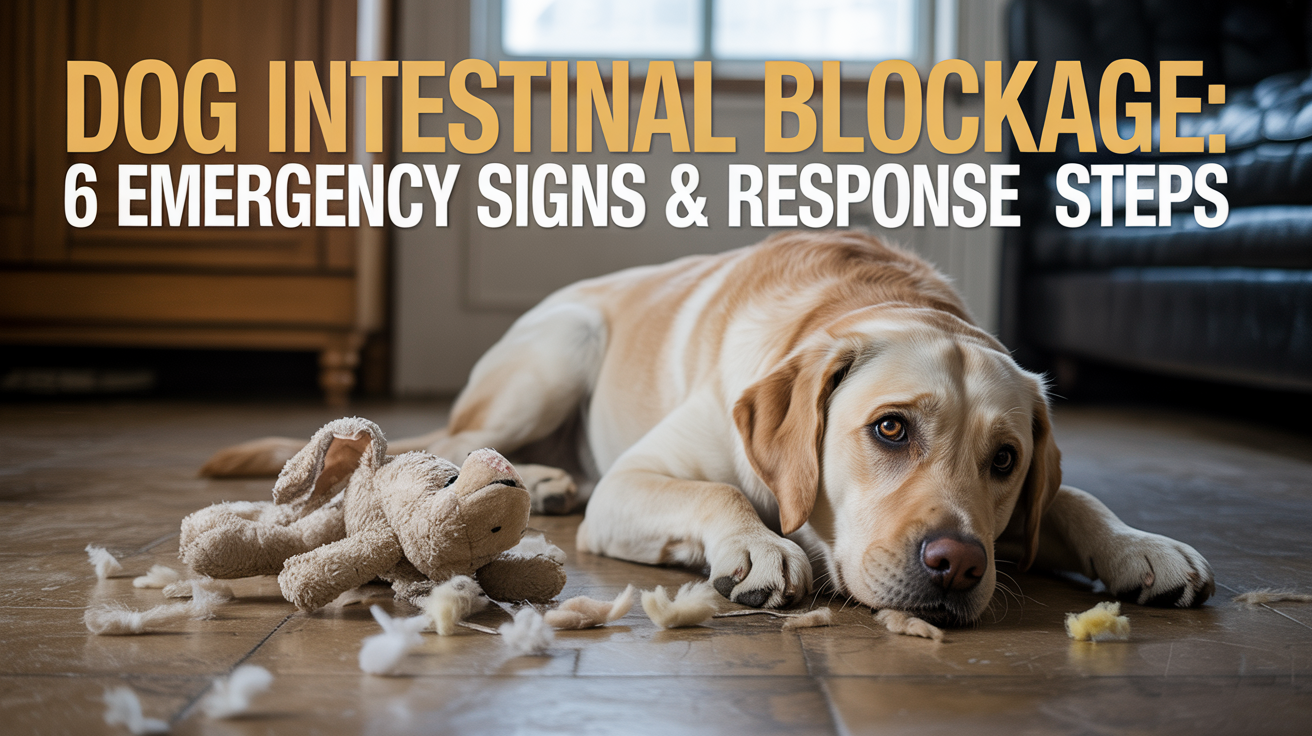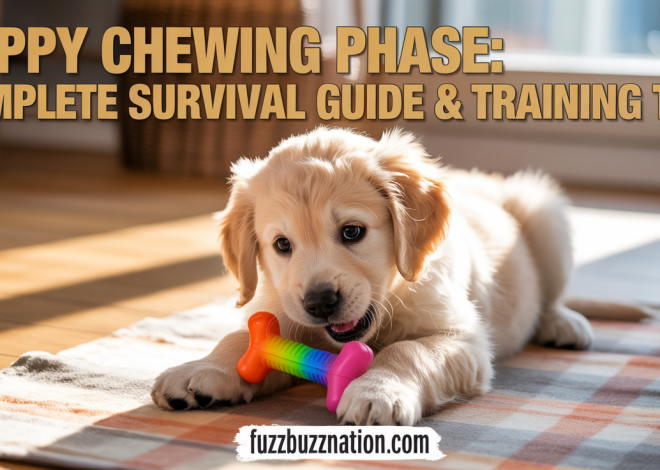
Dog Intestinal Blockage: 6 Emergency Signs & Response Steps
Recognizing intestinal blockage in dogs can mean the difference between life and death, as this condition requires immediate emergency veterinary intervention and cannot be safely treated at home. After experiencing emergency blockage situations with two foster dogs and witnessing the rapid progression of symptoms over eight years of rescue work, I’ve learned that early recognition and immediate professional treatment are the only safe approaches to this life-threatening condition.
The essential answer: Intestinal blockage is a veterinary emergency requiring immediate professional intervention. Never attempt home treatment. Symptoms include vomiting, inability to defecate, lethargy, and abdominal pain. Emergency surgery is often required, and delays in treatment can be fatal within hours.
Understanding the warning signs and knowing how to respond quickly can save your dog’s life, but attempting to treat blockages at home or delaying professional care significantly increases the risk of fatal complications.
CRITICAL MEDICAL EMERGENCY DISCLAIMER: Intestinal blockage is a life-threatening emergency requiring immediate veterinary intervention. NEVER attempt to treat blockages at home with laxatives, oils, or other remedies, as these can worsen the condition and cause fatal complications. If you suspect blockage, contact emergency veterinary care immediately. Time is critical – delays can result in tissue death, sepsis, and death within hours.
Critical Sign 1: Persistent Vomiting and Inability to Keep Food Down
Understanding Blockage-Related Vomiting
Vomiting from intestinal blockage differs from typical stomach upset by its persistence and progression. Dogs with blockages cannot keep anything down, including water, and the vomiting often becomes more frequent and forceful over time.
My foster dog Charlie demonstrated classic blockage vomiting after swallowing a tennis ball. He vomited repeatedly every 30-60 minutes, producing first food, then bile, then clear fluid as his stomach emptied completely but the vomiting reflex continued.
The vomiting may initially contain food particles but progresses to yellow bile and eventually clear or frothy liquid as the stomach empties. In severe cases, the vomit may contain fecal material as intestinal contents back up.
Unlike food poisoning or dietary indiscretion, blockage vomiting doesn’t improve with time or fasting. The persistence and worsening nature distinguish it from less serious digestive upset.
Progression Patterns and Timing
Early blockage vomiting may seem like normal stomach upset, but it quickly becomes more frequent and severe. Dogs may vomit every 15-30 minutes in advanced cases.
The timing often correlates with eating or drinking attempts, as anything entering the stomach cannot pass through the blocked intestine and must be expelled upward.
Projectile vomiting may occur as pressure builds behind the blockage, creating forceful expulsion that differs from normal regurgitation or stomach upset.
The dog’s condition deteriorates rapidly as dehydration and electrolyte imbalances develop from the constant fluid loss through vomiting.
Critical Sign 2: Complete Inability to Defecate or Abnormal Straining
Recognizing Defecation Problems
Dogs with intestinal blockages cannot produce normal bowel movements because material cannot pass through the blocked area. They may strain repeatedly without producing anything or only produce small amounts of liquid.
The absence of normal feces is a critical warning sign, especially when combined with other symptoms. My experience with emergency cases showed that owners often don’t immediately notice the lack of defecation until other symptoms become severe.
Straining without production, unusual posturing, or producing only liquid or mucus instead of formed stool indicates serious intestinal dysfunction requiring immediate evaluation.
Some dogs may pass a small amount of liquid around a partial blockage initially, but this quickly stops as the condition progresses or if the blockage becomes complete.
Time-Critical Nature of This Symptom
Normal dogs defecate at least once daily, making the absence of bowel movements for 24-48 hours a serious concern when accompanied by other symptoms.
The combination of vomiting and inability to defecate creates a dangerous situation where the digestive system cannot eliminate waste or maintain fluid balance.
Partial blockages may allow some liquid to pass initially, but complete blockages prevent all intestinal content movement, creating rapid emergency situations.
The progression from partial to complete blockage can happen quickly, making early recognition and intervention crucial for successful outcomes.
Critical Sign 3: Severe Abdominal Pain and Abnormal Posturing
Identifying Pain Behaviors
Dogs with intestinal blockages show characteristic pain behaviors including hunched posturing, reluctance to move, and sensitivity to abdominal touch. They may adopt a “prayer position” with front legs down and rear end elevated.
My foster dog’s behavior during his blockage emergency included constant position changes, inability to get comfortable, and obvious distress when his abdomen was touched even gently.
Whimpering, panting, or other vocalizations may accompany the pain, particularly when the dog attempts to move or when pressure is applied to the abdominal area.
The pain often intensifies over time as intestinal tissues become compromised and internal pressure increases from the backup of intestinal contents.
Progressive Pain Patterns
Initially, the pain may be intermittent as intestinal contractions attempt to move material past the blockage. This creates waves of discomfort that worsen over time.
As the condition progresses, the pain becomes constant and severe as intestinal tissues begin to suffer from lack of blood flow and tissue death may begin.
Dogs may become increasingly restless and unable to find comfortable positions, constantly moving or changing posture in attempts to relieve the internal pressure and pain.
In advanced cases, dogs may become listless and depressed as shock begins to develop from the systemic effects of the blockage and tissue compromise.
Critical Sign 4: Rapid Deterioration in Energy and Responsiveness
Understanding Systemic Effects
Intestinal blockages cause rapid systemic deterioration as the body cannot maintain normal fluid and electrolyte balance. Dogs become increasingly lethargic and unresponsive as the condition progresses.
The combination of dehydration from vomiting and the body’s inflammatory response to the blockage creates systemic effects that can progress to shock and organ failure quickly.
My emergency veterinary consultations revealed that dogs can go from seemingly mild symptoms to life-threatening shock within 6-12 hours, emphasizing the time-critical nature of this condition.
Mental status changes including confusion, disorientation, or unresponsiveness indicate advanced systemic compromise requiring immediate intensive care intervention.
Rapid Timeline of Deterioration
What may start as mild lethargy can progress to complete collapse within hours as the body’s systems become overwhelmed by the effects of the blockage.
Dehydration develops rapidly from constant vomiting combined with the inability to retain fluids, creating a dangerous cycle that accelerates systemic compromise.
Temperature regulation may become impaired, with dogs developing fever initially followed by below-normal temperatures as shock develops.
The progression from alert to critical can happen so quickly that owners who wait to seek care may find their dog in life-threatening condition by the time they reach veterinary help.
Critical Sign 5: Distended or Rigid Abdomen
Physical Abdominal Changes
The abdomen may become visibly distended, firm, or rigid as intestinal contents and gas accumulate behind the blockage. This physical change indicates serious internal pressure buildup.
Gentle palpation may reveal abnormal firmness, unusual masses, or extreme sensitivity that differs from the normal soft, pliable feel of a healthy abdomen.
My training in recognizing emergency symptoms included learning that abdominal distension combined with other blockage symptoms indicates advanced condition requiring immediate surgical intervention.
The distension may be localized to specific areas initially but often becomes generalized as the condition progresses and more of the intestinal tract becomes affected.
Dangerous Progression Indicators
Rapid increase in abdominal size over hours indicates worsening blockage with increased internal pressure that can compromise blood flow to intestinal tissues.
The abdomen may feel drum-tight or rigid, indicating severe internal pressure that can lead to tissue death and rupture if not relieved quickly through surgery.
Gas accumulation behind the blockage creates additional pressure that can compromise the blood supply to intestinal walls, leading to tissue death and potential rupture.
Any sudden change in abdominal appearance or feel warrants immediate emergency evaluation, as these changes can indicate life-threatening progression.
Critical Sign 6: Dehydration and Collapse Symptoms
Recognizing Dehydration
Skin tenting (slow return when skin is lifted and released), sticky gums, and sunken eyes indicate significant dehydration that develops rapidly in dogs with blockages due to constant vomiting and inability to retain fluids.
The gums may become pale, tacky, or dry instead of the normal pink and moist appearance, indicating poor circulation and dehydration.
My emergency experience showed that dehydration can become severe within hours in small dogs or those who vomit frequently, making rapid intervention crucial.
Weakness, stumbling, or inability to stand normally indicate severe dehydration and electrolyte imbalances that can lead to organ failure.
Emergency Collapse Indicators
Collapse, inability to stand, or loss of consciousness indicate advanced shock requiring immediate emergency intervention with intravenous fluids and emergency surgery.
Pale or blue gums signal poor circulation and oxygen delivery that can indicate impending cardiovascular collapse.
Rapid, weak pulse or abnormal heart rhythms may develop as the cardiovascular system responds to shock and electrolyte imbalances.
Any sign of collapse or severe weakness warrants immediate emergency transport to the nearest veterinary facility capable of emergency surgery.
What NOT to Do: Dangerous Home Treatments to Avoid
Never Use Laxatives or Home Remedies
Laxatives, oils, or other home remedies can cause the intestine to contract more forcefully against the blockage, potentially causing rupture or worsening the obstruction.
Mineral oil, castor oil, or other substances intended to “lubricate” the blockage can cause aspiration pneumonia if the dog vomits and inhales the material.
My veterinary consultations emphasized that well-meaning home treatments often worsen blockages and delay critical care, reducing survival chances significantly.
These substances can also mask symptoms temporarily, giving false hope while the underlying condition continues to worsen and become more dangerous.
Avoid Feeding or Forcing Fluids
Giving food or water to a dog with suspected blockage adds to the intestinal backup and can increase vomiting, worsening dehydration and electrolyte imbalances.
Force-feeding or using syringes to give fluids can cause aspiration if the dog vomits, creating additional life-threatening complications.
The urge to “help” by providing nutrition or hydration is understandable but counterproductive when blockages prevent normal digestion and absorption.
Professional intravenous fluid therapy is required to safely address dehydration in dogs with blockages, as oral fluids cannot be retained.
Don’t Wait or “Monitor at Home”
Intestinal blockages are time-critical emergencies where hours can mean the difference between successful treatment and fatal complications.
The “wait and see” approach that might work for minor digestive upset is dangerous with blockages, as irreversible tissue damage can occur quickly.
My emergency case experience showed that dogs brought in early had much better surgical outcomes than those where owners waited to see if symptoms would improve.
Even partial blockages can become complete blockages rapidly, turning a potentially manageable situation into a life-threatening emergency.
Immediate Emergency Response Protocol
First Response Steps
Stop all food and water immediately if you suspect blockage. Do not give anything by mouth until professional evaluation determines it’s safe.
Contact your emergency veterinarian or emergency animal hospital immediately. Call while preparing to transport to save critical time.
Prepare for immediate transport by gathering your dog’s medical records, current medications, and information about what your dog may have eaten or any objects that might be missing.
Keep your dog as calm and still as possible during transport to minimize stress and avoid any unnecessary movement that might worsen internal damage.
Emergency Transportation
Use a blanket or towel to create a stretcher for large dogs who cannot walk steadily, avoiding any pressure on the abdomen during transport.
Drive carefully but quickly, avoiding sudden stops or sharp turns that might cause additional internal trauma or increase your dog’s distress.
Have someone call ahead to the emergency clinic if possible to alert them of your arrival and ensure they’re prepared for immediate evaluation.
Document symptoms, timing, and any potential causes to provide complete information to the emergency veterinary team upon arrival.
Critical Information for Veterinary Team
Provide exact timing of symptom onset, progression, and any potential causes including missing toys, bones, or other objects your dog might have consumed.
List all recent foods, treats, medications, or supplements given in the past 48 hours, as this information helps guide diagnostic and treatment decisions.
Describe the dog’s normal bowel movement patterns and any changes observed, including the last normal defecation time and characteristics.
Include information about your dog’s previous health history, current medications, and any prior surgical procedures that might affect treatment decisions.
Professional Treatment Options and What to Expect
Diagnostic Procedures
Emergency veterinarians will perform immediate physical examination, blood work to assess hydration and organ function, and imaging studies to locate and characterize the blockage.
X-rays or ultrasound help identify the location, size, and nature of the obstruction while assessing for complications like intestinal perforation.
IV fluid therapy begins immediately to address dehydration and electrolyte imbalances while preparing for potential surgical intervention.
Pain management and anti-nausea medications provide comfort while diagnostic procedures determine the best treatment approach.
Surgical Intervention Requirements
Most complete intestinal blockages require emergency surgery to remove the obstruction and assess intestinal tissue viability.
The surgery involves opening the abdomen, locating the blockage, and removing it while evaluating surrounding tissues for damage that might require additional repair.
In some cases, severely damaged intestinal sections must be removed and healthy sections reconnected, making early intervention crucial for preserving intestinal function.
Post-surgical recovery requires several days of hospitalization with careful monitoring, IV fluid support, and gradual return to normal feeding.
Recovery and Prognosis Factors
Early intervention before tissue damage occurs provides the best prognosis, with most dogs making full recoveries when treated promptly.
Delayed treatment increases complications including intestinal perforation, sepsis, and the need for more extensive surgery with higher risks.
Recovery time varies from several days to weeks depending on the complexity of surgery required and whether complications developed before treatment.
Long-term dietary management may be necessary if significant intestinal sections were removed, but most dogs adapt well with appropriate care.
Prevention Strategies for Future Blockages
Environmental Management
Remove or secure objects that dogs commonly swallow, including small toys, bones, socks, underwear, and other household items that create blockage risks.
Supervise dogs during play with toys and remove any items that become small enough to swallow whole or that show signs of being chewed into dangerous pieces.
My household management after our blockage emergency included evaluating every accessible item for swallowing potential and securing anything questionable.
Regular toy inspection and replacement prevents dogs from accessing worn items that might break apart and create choking or blockage hazards.
Feeding and Treat Safety
Choose appropriately sized chews and treats that cannot be swallowed whole, replacing them when they become small enough to present swallowing risks.
Avoid cooked bones, which can splinter and cause blockages or perforations, sticking to safe alternatives designed specifically for dog chewing.
Monitor dogs who eat quickly or competitively, as these behaviors increase the risk of swallowing inappropriate objects or inadequately chewed food.
Establish consistent feeding routines in controlled environments where you can monitor what your dog consumes and remove potential hazards.
Frequently Asked Questions
How quickly can an intestinal blockage become life-threatening?
Intestinal blockages can become life-threatening within 6-24 hours, with some cases progressing to critical condition even faster. Complete blockages are more dangerous than partial ones, but even partial blockages can become complete rapidly. The timeline depends on the location and nature of the blockage, your dog’s size and health status, and how quickly complications develop. Never wait more than a few hours to seek emergency care if you suspect blockage, as early intervention dramatically improves survival chances.
Can some intestinal blockages resolve on their own without surgery?
Very rarely, small soft objects may pass through naturally, but you cannot safely determine at home whether a blockage will resolve naturally. Waiting to see if a blockage passes is extremely dangerous because tissue damage and life-threatening complications can develop quickly. Some partial blockages may be managed medically if caught very early, but this determination requires professional evaluation and monitoring. Never assume a blockage will resolve on its own – immediate veterinary assessment is always necessary.
What should I do if I see my dog swallow something dangerous?
Contact your veterinarian or emergency clinic immediately, even if your dog seems normal. Provide details about what was swallowed, when it happened, and your dog’s current condition. Do not induce vomiting unless specifically instructed by a veterinary professional, as some objects can cause more damage coming back up. Time is critical – early intervention may allow for non-surgical removal in some cases, while waiting often means emergency surgery becomes the only option.
How much does emergency blockage surgery typically cost?
Emergency intestinal blockage surgery typically costs $2,000-$7,000 depending on complexity, location, required hospitalization time, and whether complications develop. Simple blockage removal may be less expensive, while cases requiring intestinal resection or complication management cost more. Emergency after-hours fees and intensive care requirements increase costs significantly. Pet insurance may cover emergency surgery if the policy is already in place. Many veterinary hospitals offer payment plans for emergency situations.
How can I tell the difference between a blockage and regular stomach upset?
Blockages cause persistent vomiting that doesn’t improve with time, inability to defecate normally, severe abdominal pain, and rapid deterioration in condition. Regular stomach upset typically improves within 12-24 hours, allows normal defecation, and doesn’t cause severe pain or systemic illness. Dogs with blockages cannot keep anything down, including water, while dogs with stomach upset may be able to retain small amounts of water. When in doubt, always seek immediate veterinary evaluation – the consequences of missing a blockage are too serious to risk.
Acting Decisively to Save Your Dog’s Life
Understanding the signs of intestinal blockage and knowing when to seek emergency care can literally save your dog’s life. These situations require immediate professional intervention, and every hour of delay increases the risk of fatal complications.
The most important thing to remember is that intestinal blockages cannot be safely treated at home, and attempting home remedies can worsen the condition and delay life-saving treatment.
Trust your instincts – if your dog’s symptoms seem serious or are worsening rapidly, don’t hesitate to seek emergency veterinary care. It’s always better to have a false alarm than to lose your dog to a preventable emergency.
Prevention through environmental management and safe feeding practices provides the best protection against blockages, but when emergencies occur, quick recognition and immediate professional treatment offer the best chance for full recovery and return to normal life.


